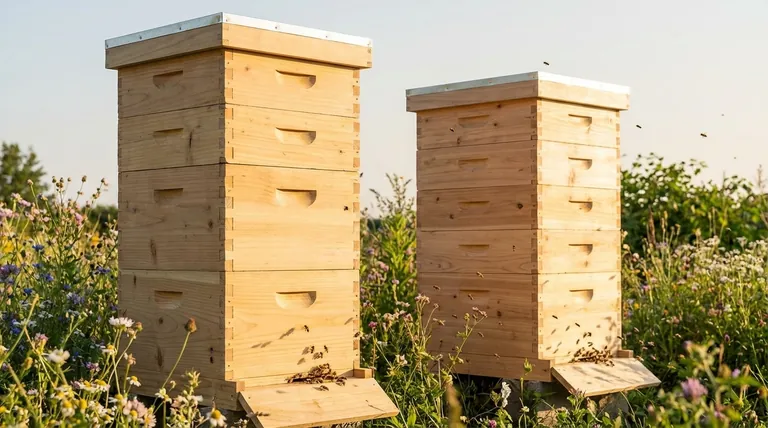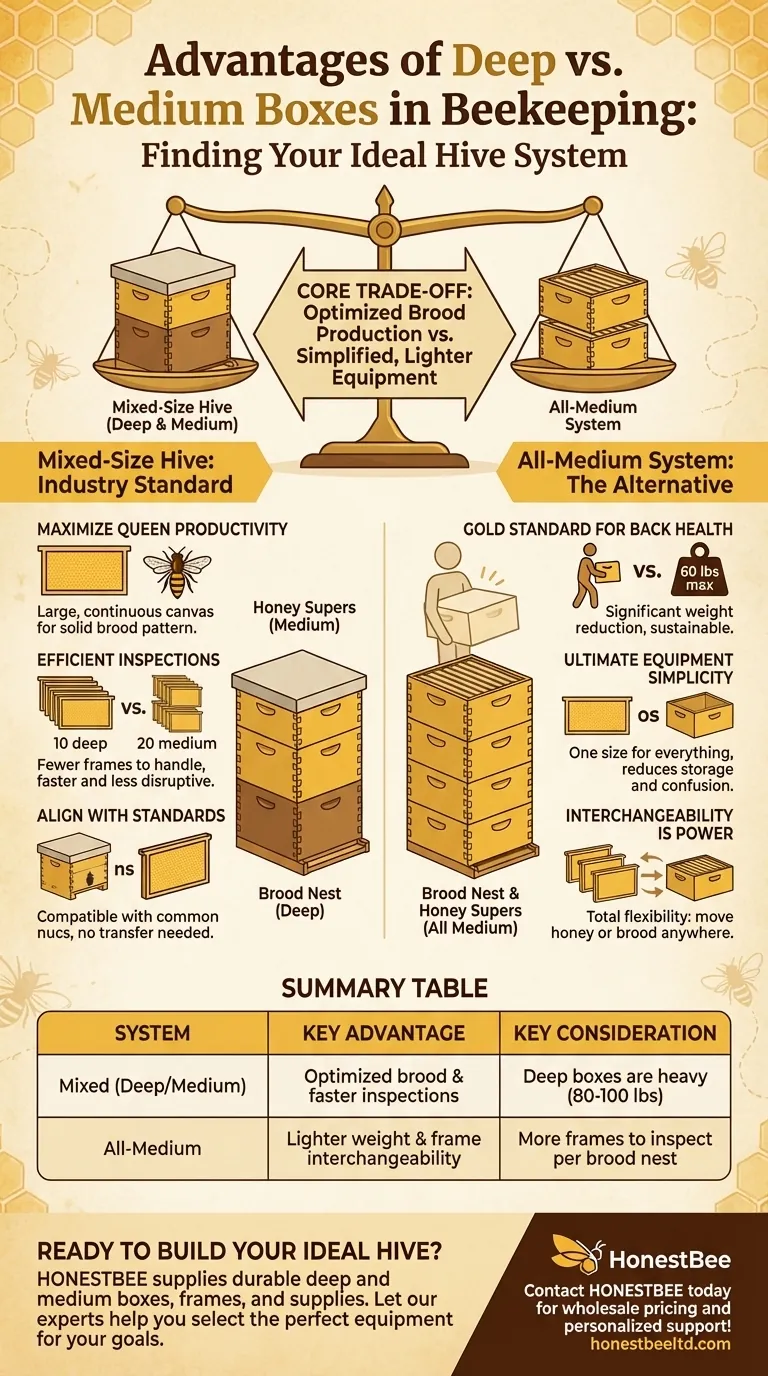Using a combination of deep and medium boxes is a standard beekeeping practice that offers distinct advantages for hive management. This setup typically involves using one or two large, deep boxes for the queen and brood nest, with smaller, medium boxes stacked on top for honey storage. The primary benefits revolve around creating an ideal environment for the queen while making hive inspections more efficient.
The choice between a mixed-size hive and a uniform, all-medium hive represents a core trade-off in beekeeping: optimized brood production versus simplified, lighter equipment. Understanding this single trade-off is the key to choosing the right system for your goals and physical abilities.

The Case for a Mixed-Size Hive
The most common hive configuration in North America is a deep brood box (or two) with medium honey supers. This method has remained popular for several well-defined reasons.
Maximizing Queen Productivity
A deep Langstroth frame provides a large, continuous canvas for the queen to lay her eggs. This unbroken comb space allows her to establish a solid, compact brood pattern, which is crucial for raising a healthy, populous colony.
This efficient pattern means the nurse bees can more effectively care for the brood and regulate the temperature and humidity of the nest.
Efficiency During Inspections
A standard deep box contains 10 frames. If you use two medium boxes for the same brood area, you would have 20 frames to manage.
Using a deep box for the brood chamber reduces the number of frames you need to remove and inspect by half. This makes inspections faster and less disruptive for the colony.
Aligning with Industry Standards
The vast majority of nucleus hives, or "nucs," are sold on deep frames. Nucs are small starter colonies that are the most common way to buy bees.
Starting with a deep brood box ensures your equipment is immediately compatible with the bees you purchase, eliminating the need to transfer a colony from one frame size to another.
The Alternative: The All-Medium System
While the mixed-size system is popular, many beekeepers choose to use only medium boxes for both the brood nest and honey supers. This approach has its own powerful advantages.
The Gold Standard for Back Health
This is the number one reason beekeepers switch to an all-medium system. A full deep box can weigh 80-100 pounds (36-45 kg), making it extremely difficult to lift.
A full medium box rarely exceeds 60 pounds (27 kg), and is often closer to 50. This significant weight reduction makes beekeeping more accessible and sustainable long-term.
Ultimate Equipment Simplicity
Using only one size of box, one size of frame, and one size of foundation simplifies your entire operation. You never have to worry about whether you have the right equipment on hand.
This uniformity reduces storage needs and minimizes confusion, a benefit that cannot be overstated, especially as you expand the number of hives you manage.
Interchangeability is Power
In an all-medium hive, every frame is identical. This means you can move a frame of honey from a honey super down to the brood nest to provide food.
More importantly, you can move a frame of brood from a strong colony to a weaker one to boost its population. This total interchangeability provides incredible management flexibility.
Understanding the Trade-offs
Neither system is inherently superior; they are simply optimized for different priorities. Your choice depends on what you value most.
The Weight vs. Inspection Time Dilemma
The core conflict is clear. A mixed system with a deep brood box is heavier to lift but faster to inspect. An all-medium system is lighter to lift but requires inspecting more frames.
Nuc Compatibility: A Real-World Constraint
While you can find nucs on medium frames, they are far less common. If you plan to buy bees, starting with at least one deep box is often the path of least resistance. However, if you plan to raise your own bees from packages or splits, this constraint is less of an issue.
Honey Supers: The Great Equalizer
Regardless of your brood box choice, most beekeepers use medium boxes for honey supers. Few beekeepers are willing or able to lift a deep box full of honey. This means even in a "mixed" system, most of your boxes will likely be mediums.
Making the Right Choice for Your Goals
Your beekeeping philosophy and physical capacity should guide your decision.
- If your primary focus is minimizing heavy lifting: An all-medium setup is the undisputed winner. The long-term benefit to your back is the most important factor.
- If your primary focus is traditional management and easy bee acquisition: The mixed deep/medium system is the industry standard for a reason and offers the best compatibility with purchased nucs.
- If your primary focus is maximum flexibility and hive manipulation: The all-medium system, with its complete frame interchangeability, offers superior control for advanced management techniques.
Ultimately, the best hive system is the one you can manage safely and consistently throughout the entire season.
Summary Table:
| System | Key Advantage | Key Consideration |
|---|---|---|
| Mixed (Deep/Medium) | Optimized brood production & faster inspections | Deep boxes are heavy (80-100 lbs) |
| All-Medium | Lighter weight & total frame interchangeability | More frames to inspect per brood nest |
Ready to Build Your Ideal Hive?
Whether you're a commercial apiary focused on maximizing brood production or a distributor seeking simplified, uniform equipment, the right box configuration is key to your success. HONESTBEE supplies the durable, high-quality deep and medium boxes, frames, and other essential beekeeping supplies you need to implement the system that best fits your operational goals and physical capacity.
Let our experts help you select the perfect equipment for a productive and sustainable season. Contact HONESTBEE today for wholesale pricing and personalized support!
Visual Guide

Related Products
- Langstroth Bee Hives Bee Keeping Box for Beginners Beekeeping
- Professional Insulated Plastic Bee Hives
- Long Langstroth Style Horizontal Top Bar Hive for Wholesale
- Wholesales Dadant Size Wooden Bee Hives for Beekeeping
- Professional Insulated Winter Hive Wrap for Beekeeping
People Also Ask
- How does the ease of access differ between 8-frame and 10-frame hives? Choose the Right Hive for Your Body
- What are the different types of beehive boxes available? Choose the Right Hive for Your Apiary
- Should a beginner try a different type of hive? Start with a Langstroth for a solid foundation.
- What basic equipment is needed to start beekeeping? Your Essential Guide to a Confident Start
- What are the key features of the Langstroth beehive? A Guide to the Standard for Modern Beekeeping



















